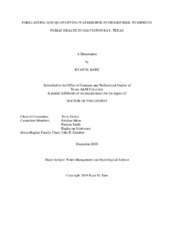| dc.description.abstract | The primary public health concern related to fecal waste contamination in recreational waters is exposure to pathogens. Noroviruses, a viral pathogen, are a leading cause of illness outbreaks in recreational waters and presence of Campylobacter spp. has risen globally. Primary contact recreation including body immersion, head immersion, and splashes to the face increase exposure to contaminated water at coastal recreational beaches. In addition, the public is vulnerable to pathogenic illnesses during and after extreme weather events since flood waters are contaminated with pathogens. A forecasting model framework was developed and assessed against the persistence method of beach management currently used at Sylvan Beach. Forecast model’s sensitivity was at least 10% better than the persistence method for 12 of 15 models. All models, except the 2015 recreational season, had specificity greater than 80%. 87% of models were determined to be greater than 30% sensitivity. Based on a threefold assessment criterion, 71% of models passed validation. The use of forecasting models can reduce management uncertainty at Sylvan Beach. Site-specific QMRA was performed to estimate total probability of illness for scenarios based on the population exposed, microbial source, recreational period, type of recreation, and ambient or elevated microbial conditions. Total probability of median illness was highest for primary contact during the recreational beach season.
The 100% human source loads consistently accounted for highest illness probability. Predicted probability of illness for child scenarios was marginally elevated compared to adult scenarios suggesting risk may not differ between the two populations. Lastly, elevated scenarios had higher overall total illness probabilities compared to ambient scenarios. However, the human load sources did not differ substantially between the ambient and elevated scenarios. Potential health risk during extreme weather was estimated utilizing forecasting and QMAR models. The results suggest that overall total probability of illness is higher for event scenarios compared to expected typically ambient conditions. Concentrations of ENT were shown to be elevated during wet years compared to dry years. This could have negative repercussions on human and environmental health as the region is expected to be impacted intensifying rain events. | en |


